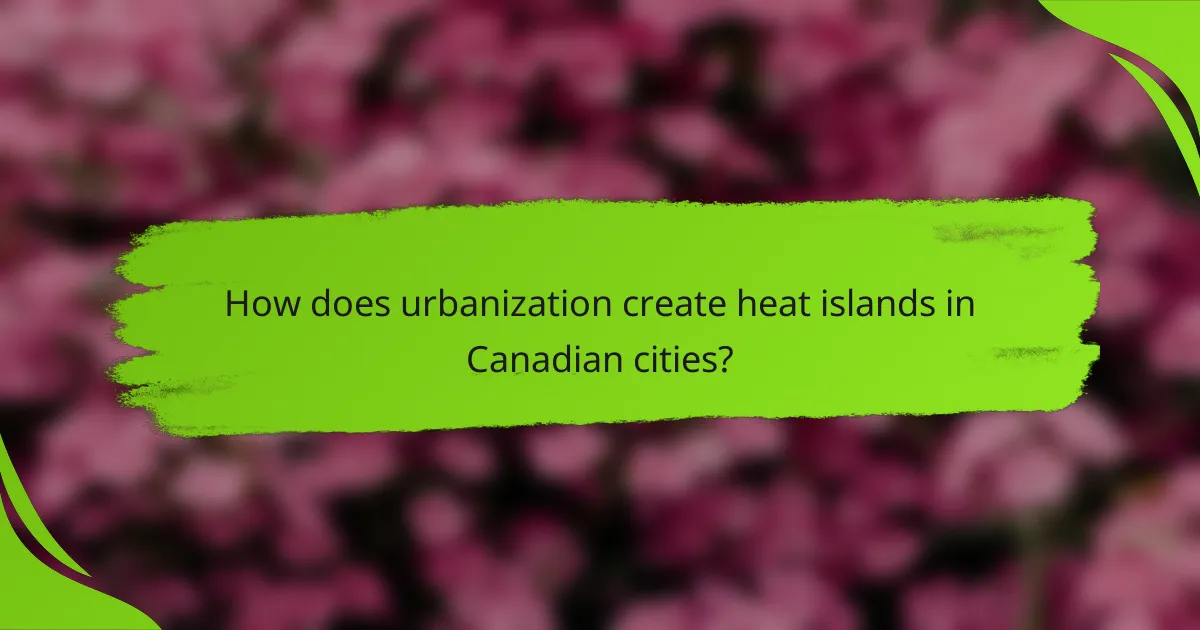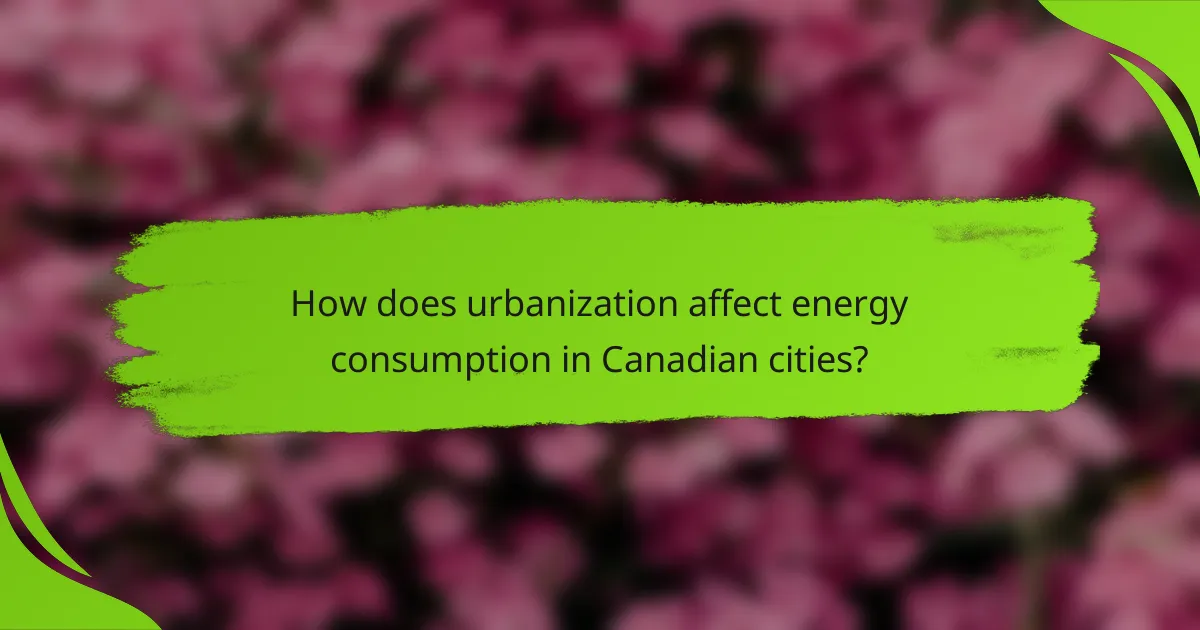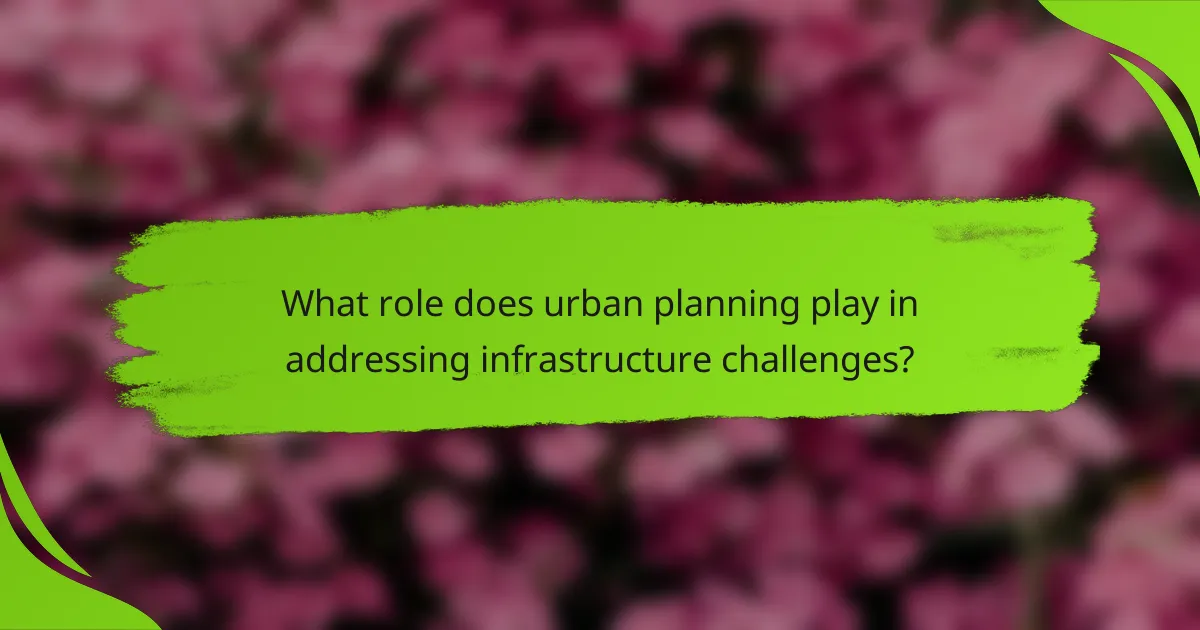Urbanization is reshaping Canadian cities, leading to the formation of heat islands that elevate temperatures and strain energy resources. As urban areas expand, the demand for transportation and public utilities intensifies, challenging existing infrastructure and necessitating sustainable development practices. This growth not only affects energy consumption patterns but also poses significant implications for public health and environmental sustainability.

How does urbanization create heat islands in Canadian cities?
Urbanization contributes to heat islands in Canadian cities by altering land surfaces and reducing natural cooling mechanisms. This phenomenon results in significantly higher temperatures in urban areas compared to their rural surroundings, impacting energy consumption and public health.
Increased concrete and asphalt surfaces
The expansion of urban areas often involves replacing natural land with concrete and asphalt, which absorb and retain heat. These materials have a lower albedo, meaning they reflect less sunlight and consequently increase surface temperatures. For instance, parking lots and roadways can elevate local temperatures by several degrees compared to green spaces.
To mitigate this effect, cities can implement reflective roofing materials and permeable pavements that allow for better heat dissipation and water absorption. Such measures can help reduce the overall heat retention in urban environments.
Reduced vegetation and green spaces
Urbanization typically leads to a decline in vegetation and green spaces, which play a crucial role in cooling the environment through shade and evapotranspiration. The loss of trees and parks not only raises temperatures but also diminishes air quality and biodiversity. For example, a city with ample green areas can be significantly cooler than one that has paved over most of its parks.
Encouraging urban greening initiatives, such as planting trees and creating community gardens, can help restore some of the cooling effects lost to urban development. These efforts can also enhance the aesthetic appeal of neighborhoods and improve residents’ quality of life.
Higher local temperatures in urban areas
As a result of increased concrete surfaces and reduced greenery, urban areas experience higher local temperatures, often referred to as the urban heat island effect. This can lead to increased energy consumption, particularly during hot summer months, as air conditioning use rises. In some Canadian cities, urban areas can be several degrees warmer than surrounding rural regions.
To address these temperature disparities, city planners can adopt strategies such as increasing green roofs, enhancing public transportation to reduce vehicle emissions, and promoting energy-efficient building designs. These actions can help lower temperatures and reduce the strain on energy resources during peak usage times.

What are the impacts of urbanization on infrastructure in Canada?
Urbanization significantly affects infrastructure in Canada by increasing the demand for transportation, straining public utilities, and necessitating sustainable building practices. As cities expand, the existing infrastructure must adapt to accommodate growing populations and changing needs.
Increased demand for transportation networks
The rise in urban populations leads to a higher demand for efficient transportation networks. This includes public transit systems, roads, and cycling paths, which must be expanded or improved to reduce congestion and enhance mobility.
In Canada, cities like Toronto and Vancouver are investing in transit upgrades and expansions, such as light rail and bus rapid transit, to meet these demands. Planning for future growth is essential to avoid gridlock and ensure accessibility for all residents.
Strain on public utilities and services
Urbanization places significant strain on public utilities, including water supply, sewage systems, and waste management. As more people move into urban areas, the existing infrastructure may struggle to keep up with increased consumption and waste generation.
Canadian cities are facing challenges in maintaining water quality and managing stormwater runoff due to aging infrastructure. Upgrading these systems requires substantial investment and careful planning to ensure they can support growing populations sustainably.
Need for sustainable building practices
The demand for new housing and commercial spaces in urban areas highlights the need for sustainable building practices. Incorporating energy-efficient designs, green roofs, and sustainable materials can help mitigate the environmental impact of urban development.
In Canada, initiatives like the LEED certification program encourage builders to adopt eco-friendly practices. By prioritizing sustainability, cities can reduce energy consumption and improve the overall quality of life for residents.

How does urbanization affect energy consumption in Canadian cities?
Urbanization significantly increases energy consumption in Canadian cities due to higher population densities and the development of infrastructure. As cities expand, the demand for energy, particularly for heating and cooling, rises sharply, impacting overall energy efficiency and sustainability efforts.
Higher energy demand for cooling systems
As urban areas grow, the heat island effect becomes more pronounced, leading to elevated temperatures in cities compared to surrounding rural areas. This results in a higher demand for cooling systems, especially during summer months, which can increase energy consumption by significant margins. For instance, energy use for air conditioning can rise by 20-30% in densely populated urban environments.
To manage this increased demand, cities may need to invest in more efficient cooling technologies or implement urban planning strategies that include green spaces to mitigate heat absorption. Simple measures like reflective roofing and increased vegetation can help reduce cooling needs.
Increased reliance on non-renewable energy sources
Urbanization often leads to a greater reliance on non-renewable energy sources, such as natural gas and coal, to meet the escalating energy demands of cities. This reliance can hinder efforts to transition to renewable energy, as infrastructure investments typically favor established energy sources. In Canada, while there is a push towards cleaner energy, urban centers still draw heavily from fossil fuels.
To counteract this trend, cities can promote policies that encourage renewable energy use, such as solar or wind installations, particularly in new developments. Incentives for energy-efficient buildings can also reduce the overall demand for non-renewable energy.
Impact on energy efficiency initiatives
The rapid pace of urbanization can undermine energy efficiency initiatives as older buildings and infrastructure may not meet modern energy standards. Cities face challenges in retrofitting existing structures to improve energy efficiency, which can lead to higher overall consumption rates. For example, older residential buildings often lack adequate insulation, resulting in increased heating and cooling costs.
To enhance energy efficiency, municipalities can implement stricter building codes and offer incentives for retrofitting older buildings. Public awareness campaigns can also educate residents on energy-saving practices, helping to reduce consumption across the board.

What strategies can mitigate heat islands in urban areas?
To mitigate heat islands in urban areas, strategies such as implementing green roofs and walls, increasing urban tree canopies, and enhancing reflective surfaces in construction can significantly reduce temperatures. These approaches not only lower heat absorption but also improve air quality and enhance urban aesthetics.
Implementing green roofs and walls
Green roofs and walls involve covering building surfaces with vegetation, which helps absorb sunlight and reduce heat. This strategy can lower indoor temperatures, decrease energy costs, and manage stormwater effectively. Cities like Chicago have seen temperature reductions of several degrees through widespread green roofing initiatives.
When considering green roofs, ensure proper waterproofing and drainage systems are in place. Native plant species are often recommended as they require less maintenance and are more resilient to local climate conditions.
Increasing urban tree canopies
Increasing urban tree canopies involves planting more trees in city landscapes, which provide shade and release moisture into the air through transpiration. This can lead to a noticeable drop in surface and air temperatures, making urban areas more comfortable during hot months. Studies suggest that a well-planned tree canopy can reduce temperatures by several degrees Fahrenheit.
To maximize effectiveness, choose tree species that are well-suited to local conditions and consider their growth patterns to ensure they provide adequate shade over time. Community involvement in tree planting initiatives can also enhance local engagement and maintenance efforts.
Enhancing reflective surfaces in construction
Enhancing reflective surfaces in construction means using materials that reflect rather than absorb heat, such as light-colored roofs and pavements. This can significantly lower surface temperatures and reduce the overall heat absorbed by urban environments. Cities can adopt building codes that encourage or require reflective materials in new developments.
When selecting materials, consider options like cool roofing systems, which can reflect up to 70% of sunlight. Regular maintenance is essential to ensure these surfaces remain effective, as dirt and debris can diminish their reflective properties over time.

What role does urban planning play in addressing infrastructure challenges?
Urban planning is essential for tackling infrastructure challenges by creating efficient, sustainable environments that accommodate growing populations. It involves strategic design and management of urban spaces to enhance livability while minimizing negative impacts like heat islands and energy consumption.
Integrating smart city technologies
Smart city technologies enhance urban infrastructure by utilizing data and connectivity to improve services and resource management. For example, smart traffic systems can reduce congestion and lower emissions by optimizing traffic flow, while smart grids can enhance energy efficiency and reliability.
Implementing these technologies requires collaboration between government, private sectors, and citizens. Cities can start by investing in sensor networks and data analytics platforms to monitor urban conditions and inform decision-making.
Promoting mixed-use developments
Mixed-use developments combine residential, commercial, and recreational spaces, reducing the need for long commutes and fostering community interaction. This approach can help mitigate heat islands by incorporating green spaces and promoting walkability, which encourages outdoor activity and social engagement.
Urban planners should prioritize zoning regulations that support mixed-use projects, ensuring that essential services are within walking distance for residents. This strategy not only enhances quality of life but also decreases energy consumption associated with transportation.
Encouraging public transportation options
Public transportation is vital for reducing traffic congestion and lowering overall energy consumption in urban areas. By investing in reliable and accessible transit systems, cities can provide alternatives to car travel, which helps decrease greenhouse gas emissions and improve air quality.
Effective public transportation planning includes expanding bus and rail networks, ensuring affordability, and integrating services to create seamless travel experiences. Cities should also consider implementing incentives for using public transit, such as reduced fare programs or subsidies for low-income residents.

How can energy consumption be optimized in urban settings?
Energy consumption in urban settings can be optimized through various strategies, including the adoption of energy-efficient technologies, improved infrastructure, and smart energy management systems. These approaches not only reduce energy use but also lower costs and environmental impact.
Adopting energy-efficient appliances
Energy-efficient appliances significantly reduce energy consumption in urban households and businesses. These devices are designed to use less electricity while maintaining the same level of performance, which can lead to substantial savings on utility bills.
When selecting appliances, look for those with Energy Star ratings or equivalent certifications, which indicate compliance with energy efficiency standards. For example, energy-efficient refrigerators can use up to 50% less energy than older models, translating to savings of around $200 over their lifetime.
Consider replacing incandescent bulbs with LED lighting, which uses about 75% less energy and lasts significantly longer. Additionally, ensure appliances are properly maintained to maximize their efficiency and lifespan, avoiding common pitfalls such as neglecting regular cleaning and upkeep.
